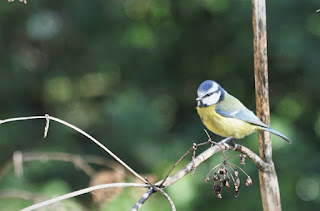Yesterday I was invited to meet our Madam Mayor, Councillor Teji Barnes, as she began a four day walk starting at Cranford Country Park and eventually finishing at Harefield.
When I arrived at the park the Mayor and her assistant were being shown around St Dunstans church by Father Michael, Bob Barton (the secretary of the Cranford Park Friends group) and Charmian Baker (our Project Manager for the Cranford Park Heritage Lottery Fund Project).
After our chat to Father Michael we started to show the Mayor the best of the rest at Cranford Park.
 |
| Myself, Bob, Charmian and Madam Mayor |
Whilst we were in the courtyard admiring the stable block, the donated clock from Hampton Court and the wild bee hive in one of the arches I spotted a Common Buzzard soaring over....
After a few horrible days of dark skies and plenty of rain, the sun came out for us and made everything seem vibrant and alive.
The walk took us through the north side of the park where we found plenty of these beautiful creations amongst the dog roses. They are commonly called Robin's Pincushion and are a type of gall caused by a gall wasp called Diploepis rosae. The larvae of this tiny wasp live inside the fluffy red gall and feed on the tissue, emerging as adults in spring through tiny holes that they burrow out of. The galls are widespread and common, but only found on wild roses. The gall darkens with age and turns red as it matures.
After I bid Bob, Charmian and the Mayor and her assistant goodbye I went to examine the young oaks by the River Crane. I was looking for more galls and it didn't take long to find some. All three galls below are only found on oaks.
The wonderfully named Spangle Gall ….
The Oak Apple or Marble Gall ….
and my favourite, the Knopper Gall ….
They start off green and sticky, eventually hardening and turning red, and by late autumn they are rock hard and dark brown. Again inside this weird structure is a larva of a gall wasp, this one is called Andricus quercusalicis, and it will emerge as an adult in the spring.
Along the Haha wall a Blue Tit was investigating the nooks and crannies for any tasty titbits …
Now they have finished nesting and rearing their young, their resplendent colourful plumage is back and in the great light of yesterday they really were lovely to see …
I completed probably my last UK Butterfly Monitoring Scheme (UKBMS) transect of the season with just two butterflies to record. One was a Large White, and the other was this vibrant Small Copper with a slightly damaged upper wing …
In Cranford Woods the most predictable fungi are starting to fruit.
The sunny Yellow Stagshead fungus was found where I always find it, on a fallen log near to the wooden bridge. As it grows the tips of each prong will separate and create separate prongs, which is where this little fungi gets it's name from …
The aptly named Dead Mans Fingers was also found where I have seen it before, a bit deeper in the woods but again on a rotting fallen tree ….
The knobbly black King Alfreds Cakes springs up everywhere and turns harder with age ….
Now the leaves are starting to fall in the woods, the holly berries are emerging and adding lovely splashes of colour …
and the huge clumps of mistletoe below can be seen from the wooden bridge ….
I finished my walk by the River Crane and spotted this stunning Banded Snail amongst the dying back vegetation ….
A truly lovely day for a walk in the park and apart from catching up with Madam Mayor, Bob and Charmian, I also got to see Ron and Lynne in the allotment garden and Phil with his two beautiful dogs, Ellie and Scruff.



















No comments:
Post a Comment